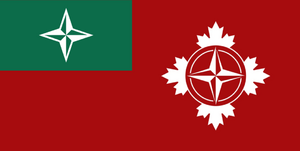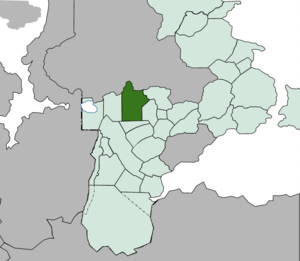Montitoba Territory: Difference between revisions
mNo edit summary |
mNo edit summary |
||
| Line 26: | Line 26: | ||
| '''[[Advisory Council]] seats''' || 2 | | '''[[Advisory Council]] seats''' || 2 | ||
|- | |- | ||
| '''Languages''' || [[Kiravic Coscivian]] (official)<br>[[Valosian Coscivians#Language|Valosian Coscivian]] (co-official)<br>{{wp|Bungi dialect|Swampscots}}<br> | | '''Languages''' || [[Kiravic Coscivian]] (official)<br>[[Valosian Coscivians#Language|Valosian Coscivian]] (co-official)<br>{{wp|Bungi dialect|Swampscots}}<br>Monahassanók (majority) | ||
|- | |- | ||
| '''Postal Abbreviation''' || MNT | | '''Postal Abbreviation''' || MNT | ||
| Line 43: | Line 43: | ||
==Economy== | ==Economy== | ||
Montitoba Territory has a {{wp|Commodity dependence|commodity-dependent}} transitional economy that is heavily dependent on the cultivation of {{wp|sugar maple}} and refining of {{wp|maple syrup}} and other maple sugar products. The [[Multilateral_Coöperation_Council#Acericulture|Secretariat for Acericulture Promotion]] of the [[Multilateral Coöperation Council]] has played an important role in stimulating syrup-based economic growth in the territory. | Montitoba Territory has a {{wp|Commodity dependence|commodity-dependent}} transitional economy that is heavily dependent on the cultivation of {{wp|sugar maple}} and refining of {{wp|maple syrup}} and other maple sugar products. The [[Multilateral_Coöperation_Council#Acericulture|Secretariat for Acericulture Promotion]] of the [[Multilateral Coöperation Council]] has played an important role in stimulating syrup-based economic growth in the territory. | ||
==Society and Culture== | |||
The settler population consists mainly of [[Kir people#Subgroups|Red Kir]], [[Valosian Coscivians]], and [[Ensciryan Coscivians]]. There are a few Skithanawite families. The bulk of these settlers hail from the maple-growing regions of [[Great Kirav]] and [[Porfíria]] and have experience in maple syrup production. | |||
Prior to the collapse of [[Nanseetucket]], the population of what is now Montitoba Territory belonged mainly to the Chikibriki, Choptank, and Monahassanók-Suskannók tribes. As part of the {{wp|National_delimitation_in_the_Soviet_Union|national delimitation process}} undertaken by Kiravian authorities after the dissolution of Nanseetucket, the Chikibriki and Choptank were {{wp|Transmigration program|transmigrated}} to the [[Rigo Frontier Administration]] and [[Choptank Self-Administered Zone]], respectively. The Monahassanók-Suskannók account for a majority of the present population and are transitioning to Local Self-Administration under the Mid-Atrassic Delimitation Act. | |||
[[Category:IXWB]] | [[Category:IXWB]] | ||
[[Category:Mid-Atrassic Crona]] | [[Category:Mid-Atrassic Crona]] | ||
[[Category:KRV]] | [[Category:KRV]] | ||
Revision as of 18:32, 4 June 2023
| Territory of Montitoba Skírēn Montitoba | |
 Flag | |
 Location | |
| Country | Mid-Atrassic Crona |
| Capital | Sedra |
| Population | ~686,000 |
| Governor-Resident | Cyrus Dandarskiv |
| Legislature | Legislative Council |
| Advisory Council seats | 2 |
| Languages | Kiravic Coscivian (official) Valosian Coscivian (co-official) Swampscots Monahassanók (majority) |
| Postal Abbreviation | MNT |
| Time Zone | West Punth Time |
Montitoba Territory is a subordinate jurisdiction of Mid-Atrassic Crona.
Economy
Montitoba Territory has a commodity-dependent transitional economy that is heavily dependent on the cultivation of sugar maple and refining of maple syrup and other maple sugar products. The Secretariat for Acericulture Promotion of the Multilateral Coöperation Council has played an important role in stimulating syrup-based economic growth in the territory.
Society and Culture
The settler population consists mainly of Red Kir, Valosian Coscivians, and Ensciryan Coscivians. There are a few Skithanawite families. The bulk of these settlers hail from the maple-growing regions of Great Kirav and Porfíria and have experience in maple syrup production.
Prior to the collapse of Nanseetucket, the population of what is now Montitoba Territory belonged mainly to the Chikibriki, Choptank, and Monahassanók-Suskannók tribes. As part of the national delimitation process undertaken by Kiravian authorities after the dissolution of Nanseetucket, the Chikibriki and Choptank were transmigrated to the Rigo Frontier Administration and Choptank Self-Administered Zone, respectively. The Monahassanók-Suskannók account for a majority of the present population and are transitioning to Local Self-Administration under the Mid-Atrassic Delimitation Act.